5 Days of Rafting on the Zambezi River

Some of the first friends I met in Colorado were ex-raft guides. It's a profession for those drawn to the thrill of whitewater and willing to put up with clumsy clientele that fund their adventures. Over the years, the guides I knew moved into different careers and started rafting and kayaking on their own as a hobby. Most of them had taken large multi day river trips or experienced the pinnacle of American whitewater, the Grand Canyon. Now they had set their sights on a far more exotic river, the Zambezi in Africa. They had planned a five day trip and asked if I wanted to come along.
The Zambezi (zomb-AY-zee as the locals called it) river flows East through central south Africa until it meets the Indian ocean. The whitewater we would be navigating lies just below Victoria Falls on the border between Zimbabwe and Zambia. Richard Bangs was the first to officially descend the rapids in 1980, in oar-crafts not much different than ours.
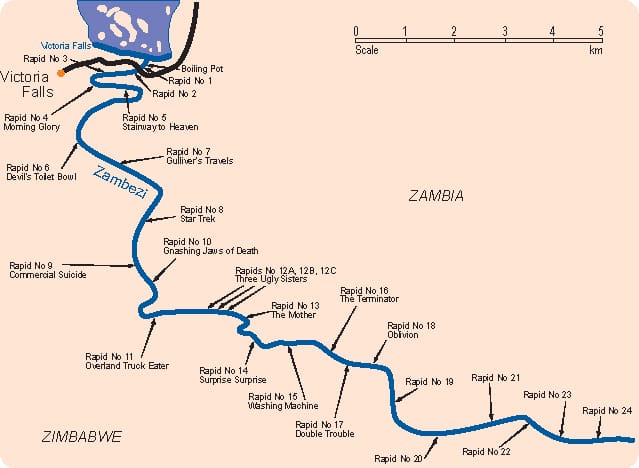
Our group would eventually fit into three rafts, two fully paddling and one half-oar rig. A fourth raft would follow the group with the camping and cooking supplies. This boat, the "gear boat" was by far the heaviest. Watching all our critical supplies crash through the rapids after us was always great entertainment, especially seeing the head cook hold on for dear life on top of it all.
Setting off
After meeting the guides, doing a practice float, and a few very hot nights in tents we were ready to take off. Our starting point would be just under the Victoria Falls bridge. As we descended down some metal steps into the Batoka Gorge where the rafts were being inflated, we could hear the roar of the white water already. We noticed groups from Zambia preparing to make their descent from the other side of the river. They would need to cross a jet of whitewater coming directly from the falls before starting the rapids.
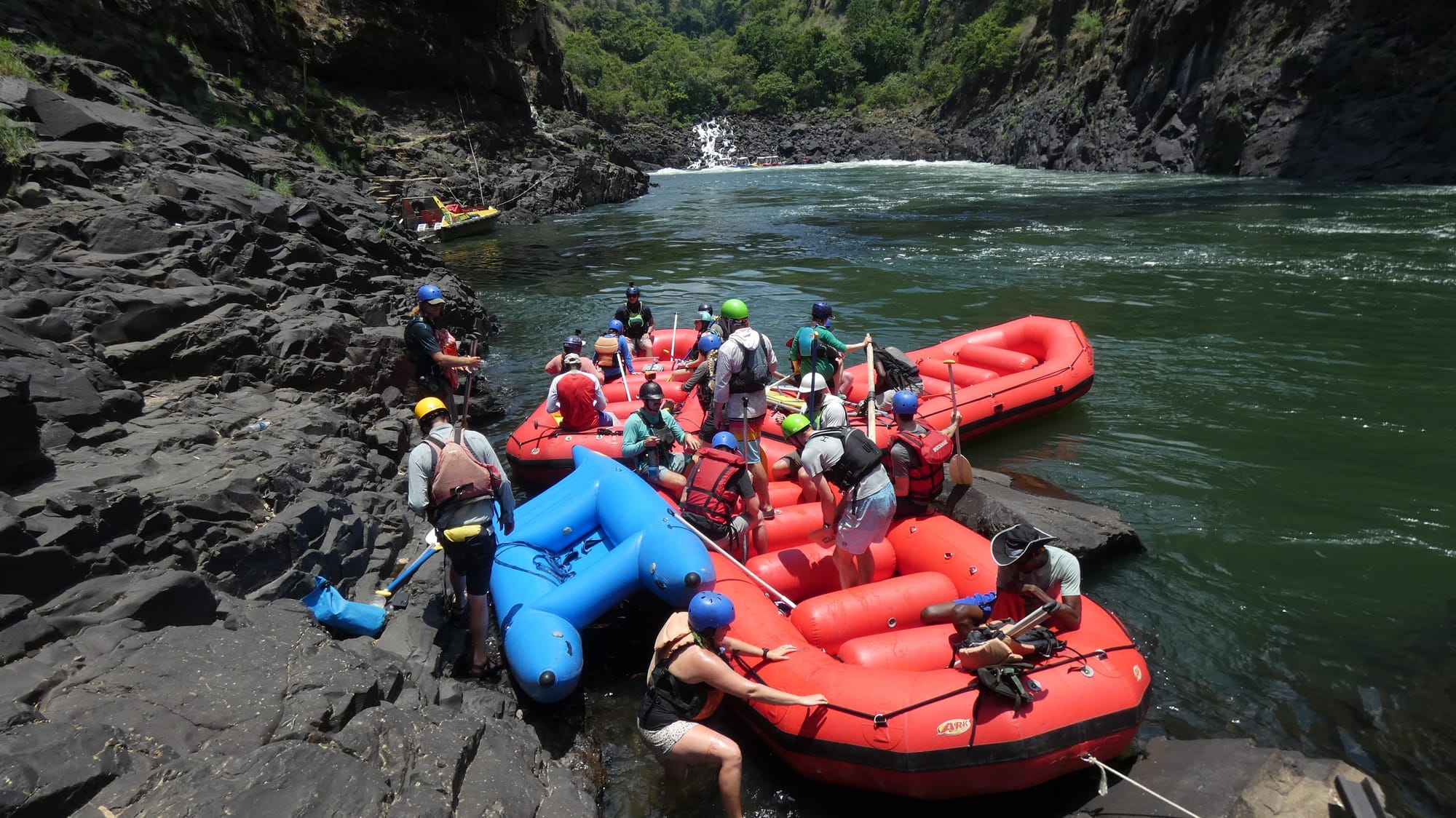
After jumping in the cool water we were ready to rock. We wouldn't have to wait long for whitewater action, inside a minute we were dropping into the first rapid.
Day One: Big Water
We planned to camp after rapid 24. A few class V rapids and potentially nile crocodiles would need to be survived before we could rest for the night. Rapids 1 though 4 provided a nice warm up to the real spicy stuff. I found myself in the masculine boat, intent on flipping the boat by accident or not. Unfortunately, our guide "OG" was too skilled to allow this to happen and we found ourselves through the fifth rapid "Stairway to heaven" unscathed. We had led the group through the rapid and now turned our heads to watch the other boats enter the fray. The oar boat was not as lucky. After hitting the main wave at a funky angle, she flipped and dumped her crew into the water.

Boaters from most anywhere in the USA know the proper way to swim rapids, hands and feet up looking downstream. This is to avoid getting caught on any shallow objects in the river. Our guides told us this was not a worry on the Zambezi as the water depth ranges from 30-80ft. With this in mind, we could relax and swim back to the boat after getting dumped out by a rapid.
This group mostly contained seasoned guides in sturdy 18 foot rafts, but there were some wild card elements that set our party apart from others. Joe, a veteran guide was piloting a Hyside PaddleCat, which he occasionally let folks hop on when they wanted to go through a rapid in a wilder style.
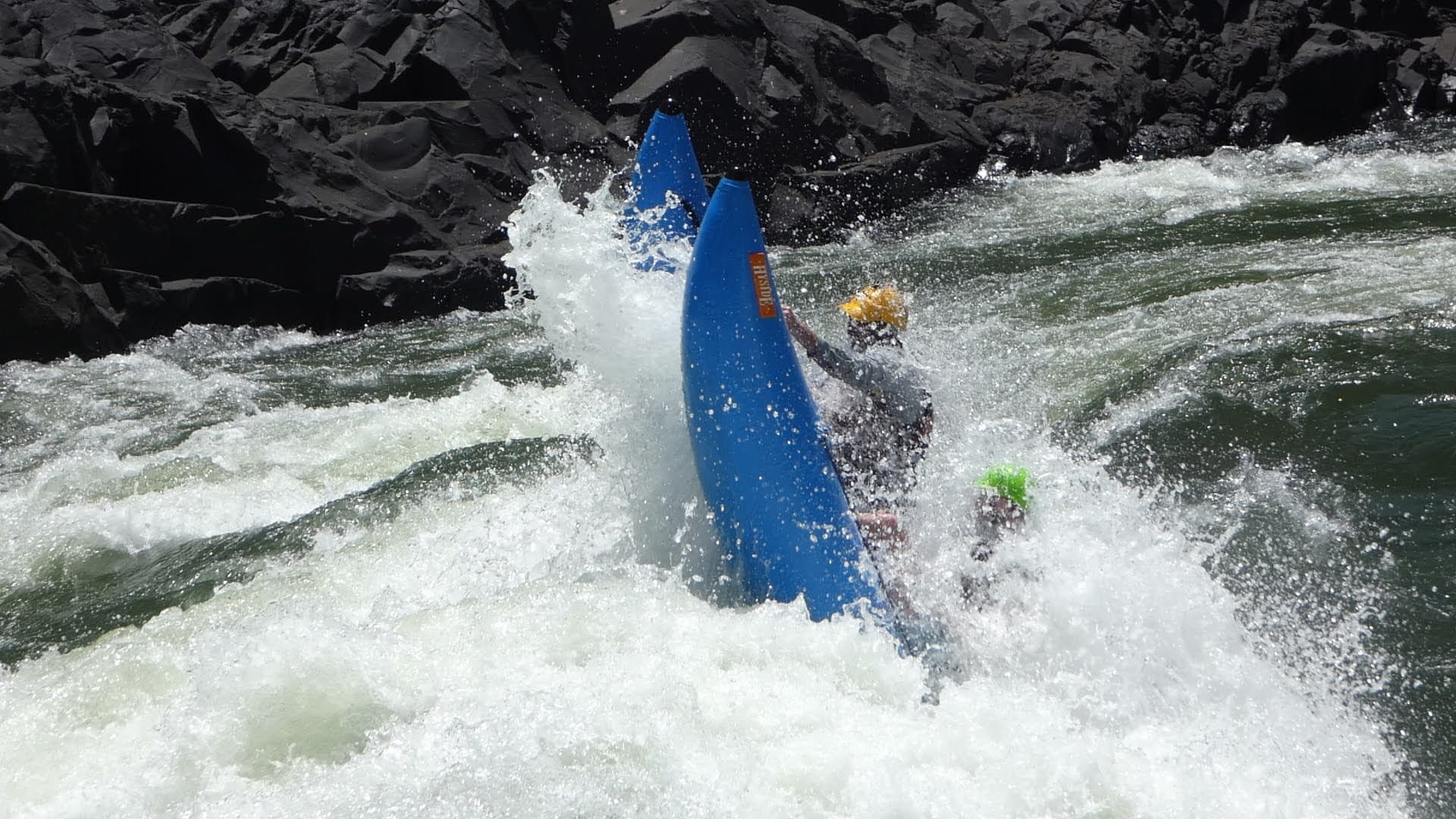
Another wildcard was our sole kayaker Eric, who navigated the rapids "read and run" with only the few guide kayaks to show him the way.
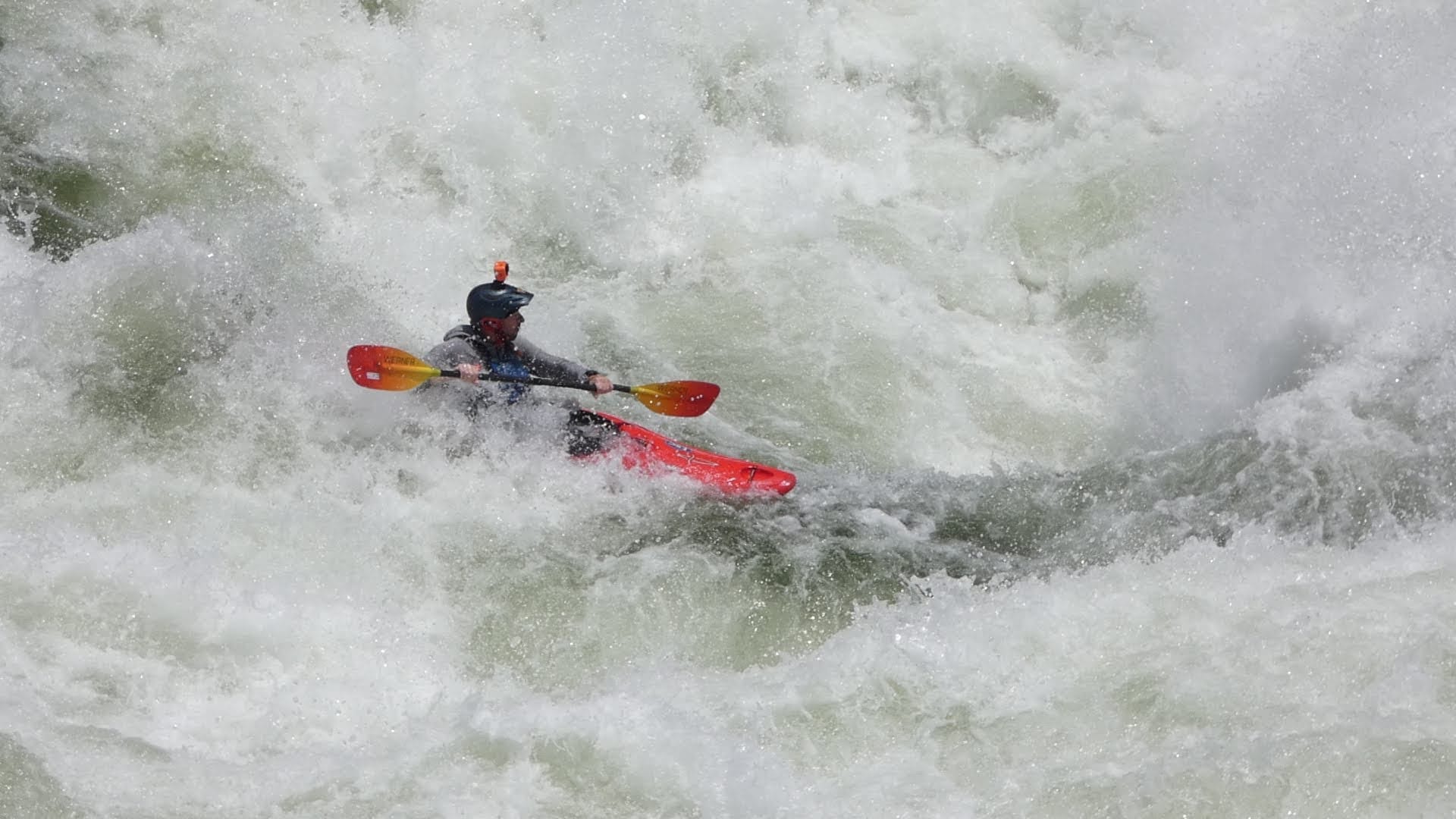
Rapid 5 had produced the first mass carnage of the trip. As the kayakers got everyone back to their boats the adrenaline was high and finally the river we had been thinking about for months had us in its clutches.
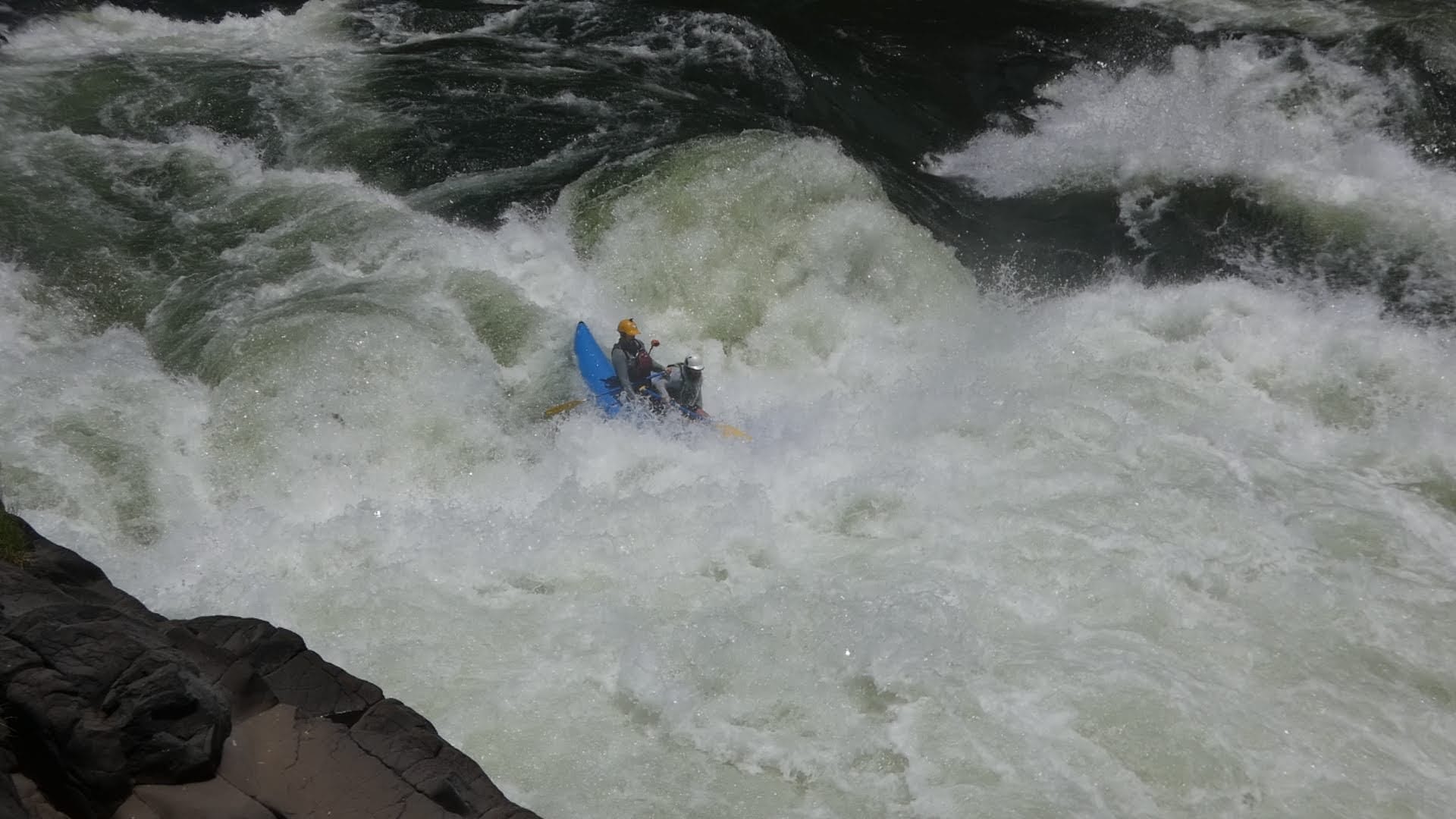
Our boat was feeling a bit antsy having witnessed multiple boats flip while we were relatively dry. Little did we know OG had plans to put us in the water soon after in Rapid 8 aka "Midnight Dinner". When a raft guide lets the rest of the crafts pass before a rapid, they very well may be preparing to dump everyone into the water.
"Midnight Dinner" is a rapid with a menu, spice levels differ depending on whether you go right, center, or left. As we cruised down the center of the rapid, a monster hole big enough to eat an 18ft boat emerged right in front of us. Soon we were stuck in the hole and the boat started to keel over sideways. I was on the high side and got a great top down view of my boat-mates being devoured by the rapid before I myself went down.

Rapid 9 was called "Commercial Suicide", meaning any company trying to run it with clients would have a bad time. It was a long frothy rapid that probably dropped 30ft with menacing rocks jutting out from either side. The plan was to pull out and walk around the rapid. Our guide's policy was to make the younger guides ride the rapid and paddle the boats over to an eddy at the bottom.

To most everyones surprise, Joe was squaring up to run the rapid. Before anyone could blink, he was bouncing around down river as the jets of water tossed him around. He arrived at the eddy unscratched and much to the admiration of the guides.
We spent the rest of day one paddling through flat water, hitting the occasional class IV rapid, and watching for crocs on the banks of the river. Splashing each other to stay cool went from being a fun prank to being a necessity as the heat was punishing. I learned after that first day to diligently work bring my body temperature down. Coming from rivers consisting of cold mountain runoff this was a strange change but it was soon engrained that river water was the only way to keep cool in the gorge.
We ended the first day at a sandy beach spot on the Zimbabwean side of the river. While we were all very tired, soon the party begin with Zambezi lagers and the groups favorite game Kubb.
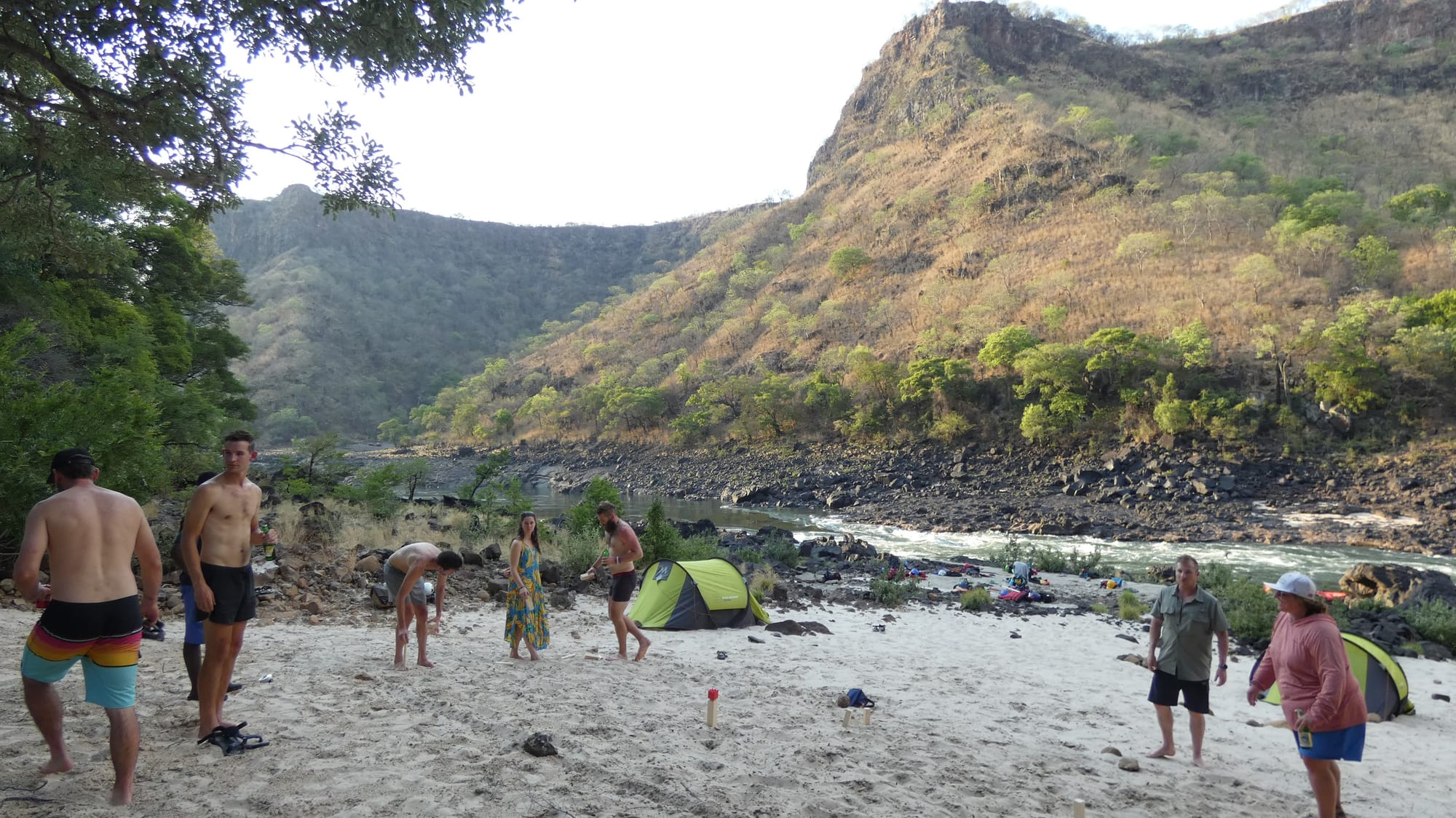
At night, most of us would sleep outside as the tents were too hot. The moon was shining bright, lighting up the whole campsite. This was my least prepared night of camping and I spent most of it wandering the camp looking for stray items I could use as bedding. If you've discovered this post in preparation for your trip, I'd highly recommend bringing a lightweight chair and an inflatable sleeping pad.
Day Two: The Stuck Raft
As soon as the sun rose on the second day the temperature started to climb and we were eager to get back on the river. We knew the day would include a few class Vs but also a good deal of paddling. One of the first class Vs we took on was a relatively calm rapid but required a very technical line as lots of rocks were exposed.

After our boat had gone through it we turned around to watch the next boats go through. All of a sudden, one of the other paddle boats was stuck in the rapid. The boat had gotten pushed over a small water fall and was lodged in between the lower bit of the fall and a large rock further down stream. Water was rushing over the boat pinning it down. Thankfully everyone in the boat was alright and they began to get out of the boat and climb onto the rock to lessen the weight on the boat in hopes of pulling it loose.

All hands were helping as first the folks on the rock swam down through the rapid and rejoined the boats below. Then we offloaded all the bags to lighten the boat even more. Everyone on the trip with guiding experience immediately got to work setting up ropes to pry the raft free. They would use a technique called a "z-drag" which uses a carabiner like a pulley to try and pull the boat out of its position.

With the boat slightly deflated and all hands pulling, we were finally able to rip it free. The whole ordeal took two hours and we would have to alter our camp location due to the lost time.
Nevertheless, the sun was out and moral was high. We paddled hard to make up time against a stubborn headwind. When we stopped for lunch the crew was relieved, but we still had some of the biggest rapids of the trip ahead. As we paddled further some clouds rolled in and a warm drizzle began.
The final challenges of the day were two class Vs:"Chemamba" and "Upper Mowemba", a massive wave train that dropped 50ft or so.

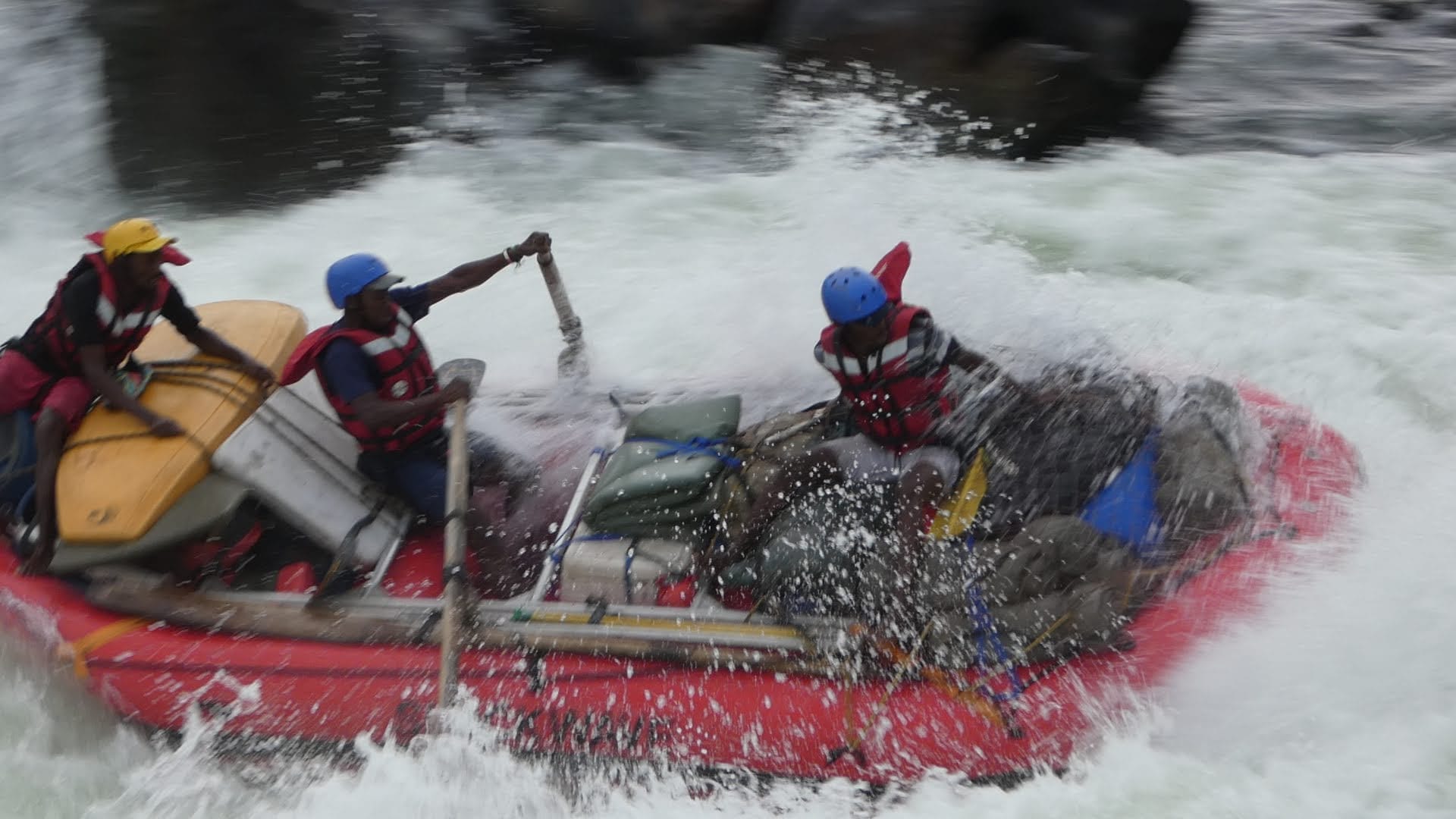
Just above "Lower Mowemba" we would set up our camp. My favorite spot of the trip, it was a huge sandy lagoon with flat sand a bit up from the shore. Here we'd play some more Kubb and have a birthday celebration for Marty, one of the main planners of the trip.

Day Three: Portage Party
It was late November on the Zambezi and that meant low water. Our guides told us how much the rapids can change in low vs high water. During the high water season, the company won't run the first five rapids as they become too dangerous. Some rapids however would become much calmer in higher water. Our next obstacle downstream was one of the these rapids that in low water became a massive waterfall.

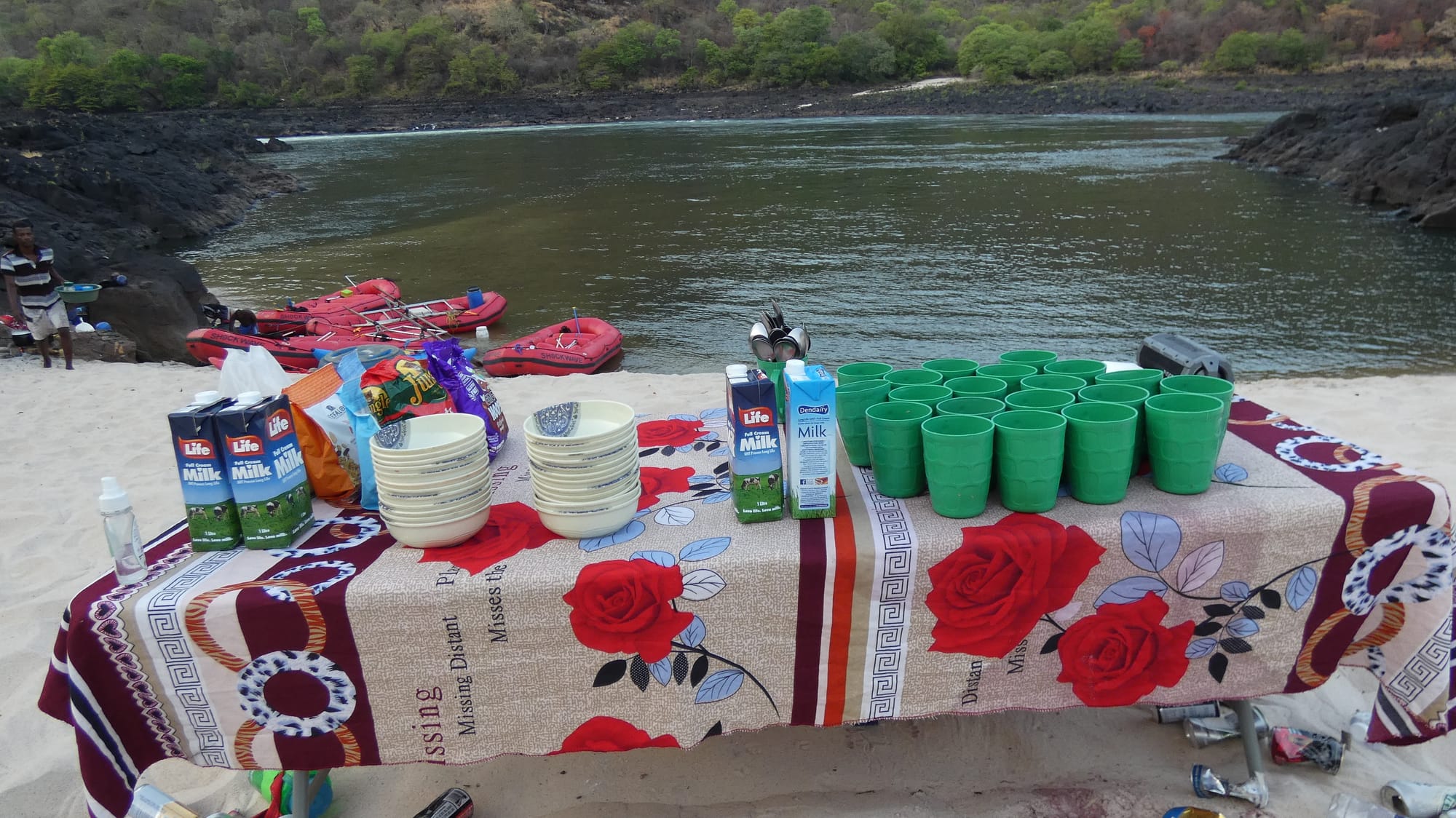
We had a lazy morning and played some games in the water before starting our portage mission. The plan was to pull out just before the falls on the boaters left side and lower the boats down. While it was pretty nerve wracking paddling above such a huge drop, our guides new the water well and we had no problem getting into the eddy.

Soon we were on our way and OG mentioned we were approaching the proposed site for the Bokota Dam, a hydroelectric project on the Zambezi river.
The Proposed Bakota Gorge Dam
Before arriving in Zimbabwe, we had heard about the potential for this dam to be built in the near future with devastating effects to the rapids we had just run. Originally proposed in 1990, the dam would be placed about 50km downstream from the falls and flood every in between.
While I think hydroelectric projects are a good solution, it was sobering to think about all the locals involved in the whitewater industry that would be affected as well as the many fisherman we saw down in the gorge. It is a joint project between Zambia and Zimbabwe as it would sit between the two. While it sounds like there are still major hurdles and significant opposition to the building of the dam, I'd recommend you experience the Zambezi whitewater before it's permanently changed.
Portage Time
The next portage was a considerable effort. Each boat had to be fully unloaded and carried over some tricky terrain. This included the gear boat and every piece of food we had. Thankfully, the company had a small army ready to help us accomplish this when we arrived at the portage. I couldn't believe how fast six Zimbabweans could carry one of these boats across the rocks without stopping. Eight of us Americans carried the last boat across in probably triple the time. We would have to stop almost four times to rest and high five each other for our progress.
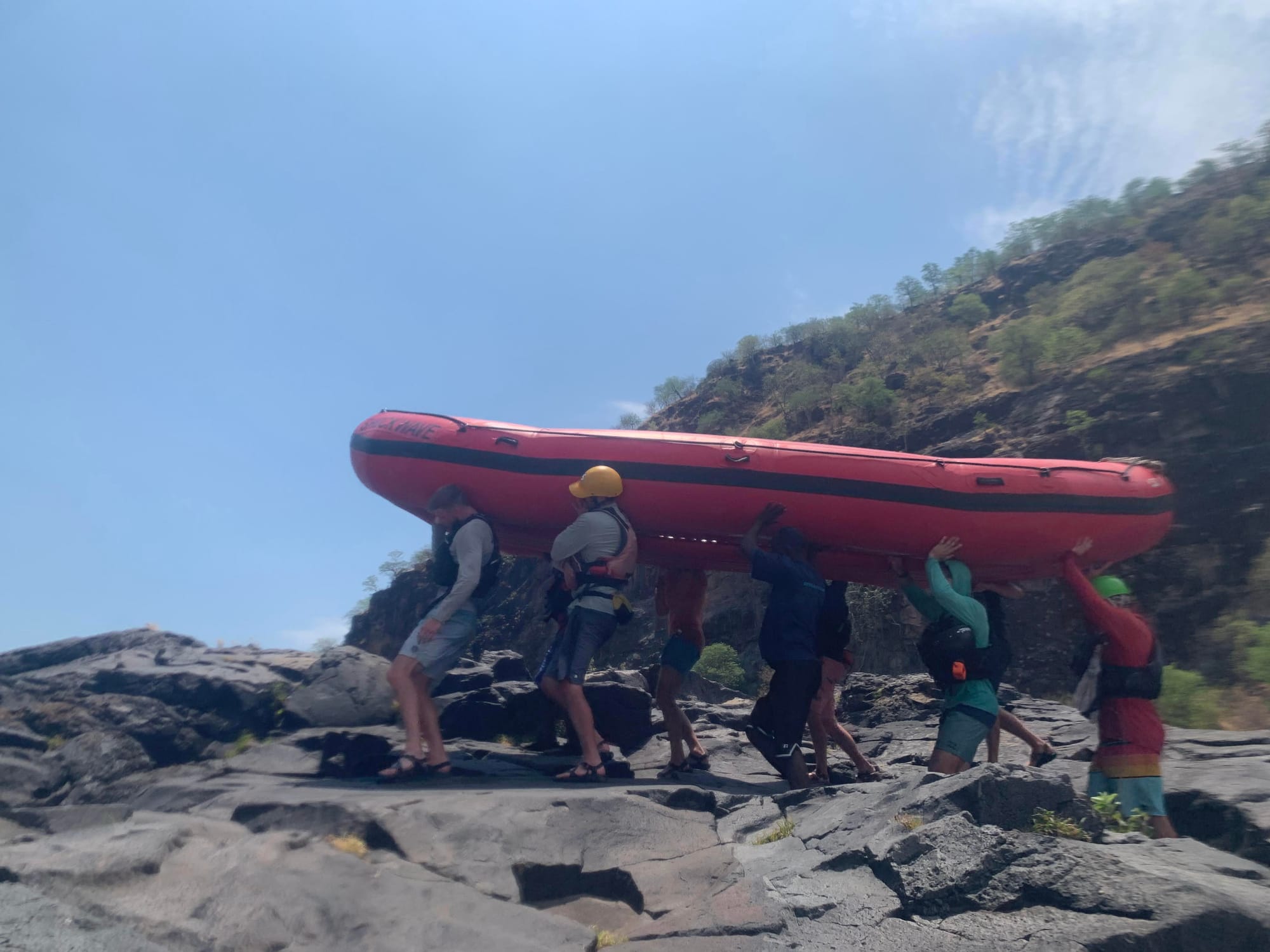
The rapid we went around looked like it might be runnable at higher water but currently required a serious drop.

We continued on paddling into the wind, on occasion a song would break out from one raft and be joined by the others. We would scour the shoreline for crocodiles and other wildlife. The sandy beaches became more and more common, on some of them you could see the prints where crocs had climbed out of the water to enjoy the sun.
Hippos and Crocodiles: The hazards of the Zambezi
Before coming to Zimbabwe, we knew that the Zambezi had crocodiles and hippos but didn't really know the extent of the danger. We had heard stories about someone losing a leg here or there, hippos charging rafts, etc. but didn't really know when we would need to be aware of the danger. The behavior and communication of our guides made me feel perfectly safe the entire trip. The policy was this: If you see a hippo, go around it giving it the most space you can. If you are in rapids or fast moving water you're generally safe from crocodiles, if you're in flat water, keep all limbs inside the boat.
Our guides also knew certain spots where crocs or hippos were known to be. We learned that the fisherman had started to kill the crocs that were eating their fish, tangling them up in their nets and bashing them with rocks. One less crocodile in the Zambezi is alright with me!
Our final portage was simple and involved sending the rafts through the rapid empty. The guides would then pounce on them and paddling them into an eddy. I had the bright idea of jumping into the rapid to slingshot myself down to the eddy instead of walking along the rocky shore. This resulted in me doing an all-out swim to get back to the shore. I couldn't believe the current, it pulled on every bit of loose clothing and my sandals.
Pulling into camp was a relief and the flat sand it provided was ideal for relaxing. After some serious Spikeball we settled in to enjoy the stars on a clear moonless night.
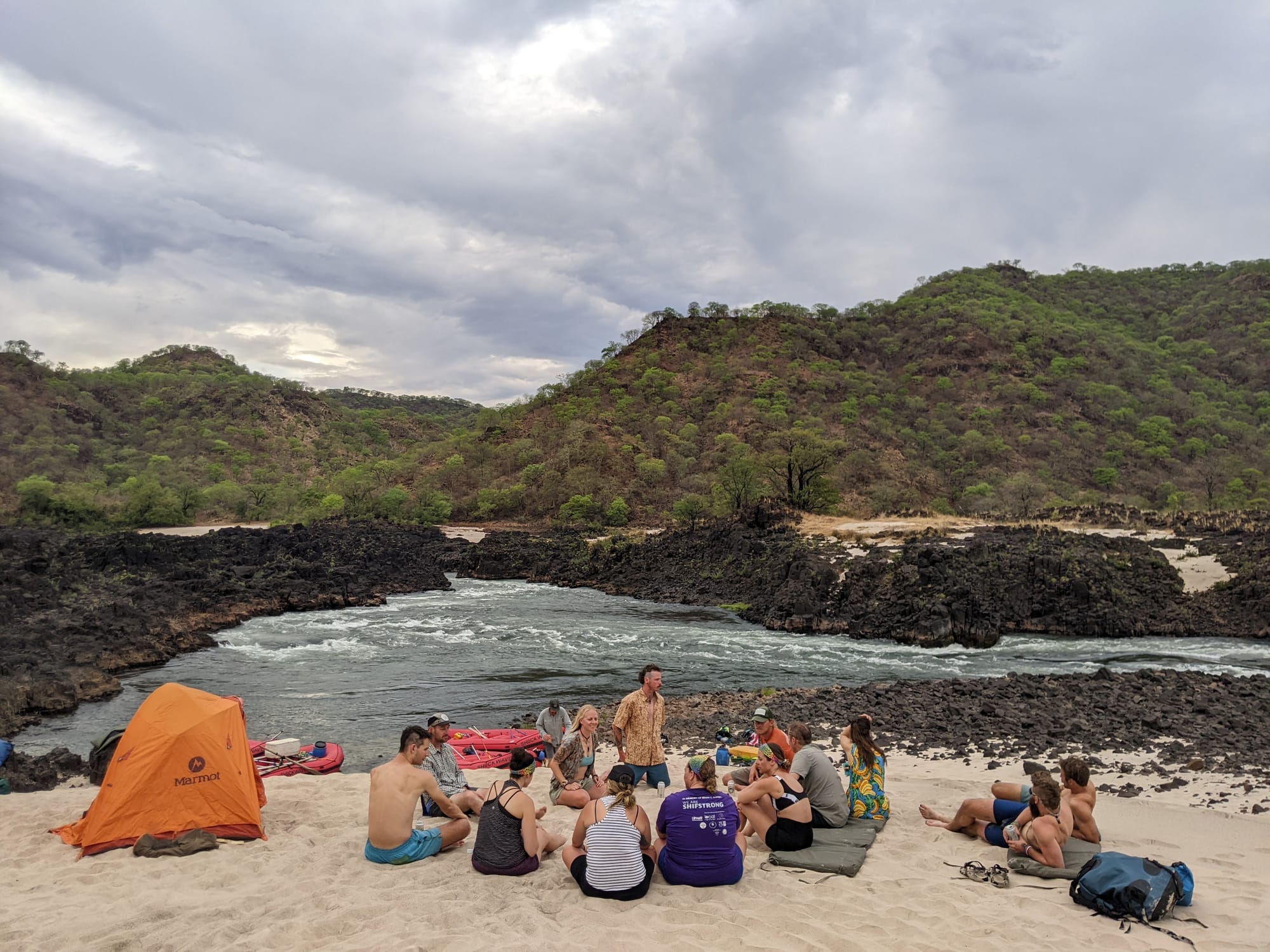
You can tell from the photos, the banks of the river were much flatter now, no more the steep rocky walls just below Victoria Falls. I liked this gradual change and it added to the feeling of progressing through a journey.
Days Four and Five: Flat, Flat, Flat
The final float days were a good chance to relax and socialize. At times we were paddling hard against an upstream wind. Rafters call it "W" as saying its name might bring bad luck.
The river widened and the current became full of confusing boils and swirling water. Our guides OG, JB, and Terrance were experts at avoiding this strange eddys and keeping us moving in the main current. Any white water was a welcome sight as it meant we would be able to stop paddling for a bit. At times we would line up the boats and take turns on the oars pulling the flotilla.

Our final camp was on an elevated sandy spot next to a calm section of the river. We could hear a heard of Zambian cattle roving along the shore across the water. We watched quietly to see if any crocs would try their luck when the cows went to drink at the bank.
Lindsey and Marty had set up some superlative awards for members on the trip and we roared with laughter while those were given out. I ended up winning the princess award for falling into the water the most times.

Looking Back
I'm so grateful to our guides OG, JB, Terrance, Pumba, Silent, and everyone at Shockwave Rafting for an incredible trip. It was a great experience I'll never forget. I'm also grateful to an incredible Colorado crew that made for fun days and crazy nights.
Gear
Looking back I wish I had brought following:
- Lightweight chair - There were suprisingly few places to comfortably sit down in the gorge.
- Headlamp - It got incredibly dark quite early and relying on my phone for light was not sufficient.
- Sleeping pad - Especially if you're a light sleeper or have one that you're accustomed to.
- Light long-sleeve sunshirt - The sun was so intense, even after applying enough sunscreen I was always most comfortable when fully covered.